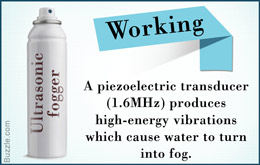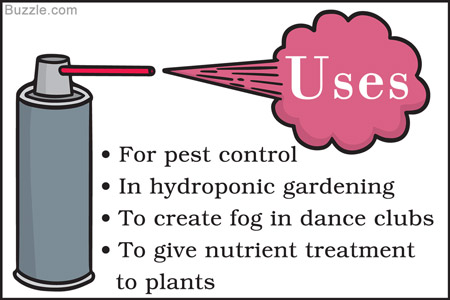





 We use different types of appliances, devices and machines everyday. But we seldom think about the principles they work on. Right from light bulbs to laptops, there are so many scientific phenomena at work, but we don't pay much attention to the engineering that goes into these machines. But there are some like us who are interested in knowing how things work.Here we discuss the working of ultrasonic foggers. Fogger is a device found in many households; and those using ultrasonics are quite popular, owing to their advantages over foggers harnessing other technologies.Ultrasonic Foggers - The Crux
We use different types of appliances, devices and machines everyday. But we seldom think about the principles they work on. Right from light bulbs to laptops, there are so many scientific phenomena at work, but we don't pay much attention to the engineering that goes into these machines. But there are some like us who are interested in knowing how things work.Here we discuss the working of ultrasonic foggers. Fogger is a device found in many households; and those using ultrasonics are quite popular, owing to their advantages over foggers harnessing other technologies.Ultrasonic Foggers - The Crux
 Ultrasonic Foggers: How they Work and the Work they DoA fogger is any device that creates fog. Usually, the fog it creates contains an insecticide for killing insects. Foggers are widely used as an alternative to pest control services. They contain pyrethroids, a kind of synthetic insecticides and pyrethrins that are insecticides derived from chrysanthemum flowers. The use of foggers is not limited to just pest control. Foggers are used to create low-hanging fog made from various chemicals, liquids or even dry ice.An ultrasonic fogger or mister uses water to produce fog. Ultrasonic waves are focused on water, causing it to turn into a dry-feeling gas. Nowadays, these foggers are popularly used to create fog in dance clubs as also in home decoration and landscaping. Owing to their capacity to generate a high level of humidity, they can be used in germination rooms or greenhouses for promoting plant growth. You can always use a humidistat for controlling and monitoring humidity levels maintained by the ultrasonic fogger.The fog units of the fogger use a piezoelectric transducer that has a resonating frequency of around 1.6MHz. These high-energy vibrations cause the water to turn into a fog-like cloud, thus generating fog. These foggers use ultrasonic waves to produce fog that consists of water particles of the size of less than 5 microns. This fog can penetrate to the tiniest of spaces, thus eliminating chances of any free water. The ultrasonic fogger circuit is not very difficult to design. These foggers have very few moving parts and require no special temperature and pressure conditions. This kind of design and working of ultrasonic foggers makes them a low-maintenance and economical appliance. Moreover, they are easy to install and use.When used for agricultural purposes, it is important that there are no free water particles that can damage the plants and that water does not condense on the plants or their growing mediums. Since ultrasonic foggers produce water particles of the size of 5 microns or less, there is no possibility of condensation on the plants' surface or their growing medium. Also, the humidity levels are such that seedlings can grow healthily.This was about creating fog of plain water. What if you add soluble chemicals to water? Will the fogger still create fog? Of course, it will! And that makes the ultrasonic fogger, a wonderful machine. The same principle of fog formation can be used in so many ways. Add insecticides to water in the fogger and its fog can be used to kill insects, add nutrient solutions to water and you will be able to give nutrient treatment to your plants.Now, something about an ultrasonic hydroponic fogger. It is a device that produces nutrient fog and is used in a hydroponic system. What is a hydroponic system? Hydroponics is the method of cultivating plants using nutrient solutions. What's the role of an ultrasonic fogger in hydroponic gardening? It is used to generate oxygenated fog mist in the root region of plants. The water particles it generates are about 5-15 micrometers in size and they are absorbed by the plants' roots. Ultrasonic hydroponic foggers thus help in accelerating the plant growth process.And now about the role of ultrasonic foggers in aeroponics. Aeroponics is a system wherein plants are cultivated in a mist environment without the use of soil or any aggregate medium. While a hydroponic system makes use of water as a growing medium, an aeroponic system is devoid of any growing medium. An aeroponic system can make use of ultrasonic foggers to create mist that provides plants with essential nutrients and minerals. One disadvantage of using this fogger in aeroponics is the size of water droplets it generates. The droplet size of a few microns can lead to excessive root hair growth in the plants and hamper the development of a lateral root system.To cut the long story short, foggers work on the principle of generating vibrations that cause water to turn into tiny droplets which vaporize to turn into fog. And ultrasonic foggers use ultrasonic waves for that. So, tomorrow if someone asks you what is an ultrasonic fogger or how does it work, show them what you just read.
Ultrasonic Foggers: How they Work and the Work they DoA fogger is any device that creates fog. Usually, the fog it creates contains an insecticide for killing insects. Foggers are widely used as an alternative to pest control services. They contain pyrethroids, a kind of synthetic insecticides and pyrethrins that are insecticides derived from chrysanthemum flowers. The use of foggers is not limited to just pest control. Foggers are used to create low-hanging fog made from various chemicals, liquids or even dry ice.An ultrasonic fogger or mister uses water to produce fog. Ultrasonic waves are focused on water, causing it to turn into a dry-feeling gas. Nowadays, these foggers are popularly used to create fog in dance clubs as also in home decoration and landscaping. Owing to their capacity to generate a high level of humidity, they can be used in germination rooms or greenhouses for promoting plant growth. You can always use a humidistat for controlling and monitoring humidity levels maintained by the ultrasonic fogger.The fog units of the fogger use a piezoelectric transducer that has a resonating frequency of around 1.6MHz. These high-energy vibrations cause the water to turn into a fog-like cloud, thus generating fog. These foggers use ultrasonic waves to produce fog that consists of water particles of the size of less than 5 microns. This fog can penetrate to the tiniest of spaces, thus eliminating chances of any free water. The ultrasonic fogger circuit is not very difficult to design. These foggers have very few moving parts and require no special temperature and pressure conditions. This kind of design and working of ultrasonic foggers makes them a low-maintenance and economical appliance. Moreover, they are easy to install and use.When used for agricultural purposes, it is important that there are no free water particles that can damage the plants and that water does not condense on the plants or their growing mediums. Since ultrasonic foggers produce water particles of the size of 5 microns or less, there is no possibility of condensation on the plants' surface or their growing medium. Also, the humidity levels are such that seedlings can grow healthily.This was about creating fog of plain water. What if you add soluble chemicals to water? Will the fogger still create fog? Of course, it will! And that makes the ultrasonic fogger, a wonderful machine. The same principle of fog formation can be used in so many ways. Add insecticides to water in the fogger and its fog can be used to kill insects, add nutrient solutions to water and you will be able to give nutrient treatment to your plants.Now, something about an ultrasonic hydroponic fogger. It is a device that produces nutrient fog and is used in a hydroponic system. What is a hydroponic system? Hydroponics is the method of cultivating plants using nutrient solutions. What's the role of an ultrasonic fogger in hydroponic gardening? It is used to generate oxygenated fog mist in the root region of plants. The water particles it generates are about 5-15 micrometers in size and they are absorbed by the plants' roots. Ultrasonic hydroponic foggers thus help in accelerating the plant growth process.And now about the role of ultrasonic foggers in aeroponics. Aeroponics is a system wherein plants are cultivated in a mist environment without the use of soil or any aggregate medium. While a hydroponic system makes use of water as a growing medium, an aeroponic system is devoid of any growing medium. An aeroponic system can make use of ultrasonic foggers to create mist that provides plants with essential nutrients and minerals. One disadvantage of using this fogger in aeroponics is the size of water droplets it generates. The droplet size of a few microns can lead to excessive root hair growth in the plants and hamper the development of a lateral root system.To cut the long story short, foggers work on the principle of generating vibrations that cause water to turn into tiny droplets which vaporize to turn into fog. And ultrasonic foggers use ultrasonic waves for that. So, tomorrow if someone asks you what is an ultrasonic fogger or how does it work, show them what you just read.
Copyright © www.100flowers.win Botanic Garden All Rights Reserved